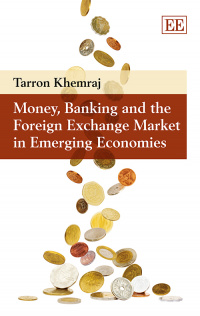Hardback
Money, Banking and the Foreign Exchange Market in Emerging Economies
Despite the financial liberalization agenda of the mid-1980s, a system of bank oligopolies has developed in both large and small, open developing economies. Mainstream monetary theory tends to assume a capital markets structure and is therefore not well suited to an analysis of these economies. This book outlines a unique theoretical framework that can be used to examine monetary and exchange rate policies in developing economies or other economies in which banks dominate external finance.
More Information
Critical Acclaim
Contents
More Information
Despite the financial liberalization agenda of the mid-1980s, a system of bank oligopolies has developed in both large and small, open developing economies. Mainstream monetary theory tends to assume a capital markets structure and is therefore not well suited to an analysis of these economies. This book outlines a unique theoretical framework that can be used to examine monetary and exchange rate policies in developing economies or other economies in which banks dominate external finance.
Giving the foreign exchange market a prominent role, this volume presents extensive econometric results and descriptive statistics to support core theoretical ideas, including both micro and macroeconomic models. Topics discussed include oligopoly market power, excess liquidity, bank concentration, interest rate spread and the implications of bank foreign exchange trading on exchange rate stability, foreign exchange rate regime choice and monetary management.
Students and scholars of development economics, money and banking, and development finance will find this book a valuable resource, as will policy makers and others affiliated with central banks in developing economies.
Giving the foreign exchange market a prominent role, this volume presents extensive econometric results and descriptive statistics to support core theoretical ideas, including both micro and macroeconomic models. Topics discussed include oligopoly market power, excess liquidity, bank concentration, interest rate spread and the implications of bank foreign exchange trading on exchange rate stability, foreign exchange rate regime choice and monetary management.
Students and scholars of development economics, money and banking, and development finance will find this book a valuable resource, as will policy makers and others affiliated with central banks in developing economies.
Critical Acclaim
‘One of the fundamental features of the financial system in most small island developing countries is the existence of oligopolistic banking systems. While economists have, for some time now, been working on developing models to explain the behaviour of firms in such market structures, this book is unique as it applies these tools to monetary models of the banking system. In doing so, the text highlights many of the important differences between banking systems in small states and those in larger and more developed markets. Applied researchers, policymakers, students and teachers examining the behaviour of financial systems in small states would find the text quite useful, as it provides fairly accessible theoretical models supported by relevant data and econometric analysis.’
– Winston Moore, The University of the West Indies
‘In 162 pages this book makes an outstanding and novel presentation of the current functioning of the banking and foreign exchange markets in emerging economies and small open economies.’
– Review of Keynesian Economics
– Winston Moore, The University of the West Indies
‘In 162 pages this book makes an outstanding and novel presentation of the current functioning of the banking and foreign exchange markets in emerging economies and small open economies.’
– Review of Keynesian Economics
Contents
Contents: 1. Motivation and scope of study 2. Stylized facts and bank liquidity preference 3. Oligopolistic banking, compensation and financial stability 4. The bank liquidity trap 5. Compensation and endogenous money in an open economy 6. The investment demand constraint and the FX market 7. Concluding remarks References Index




